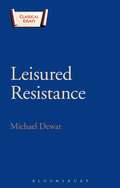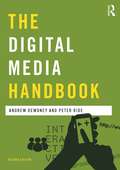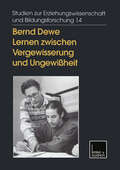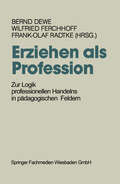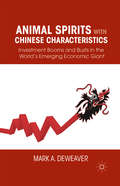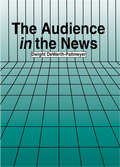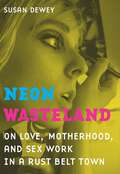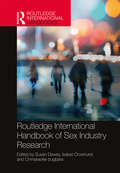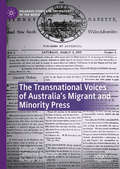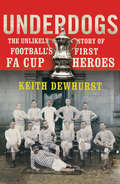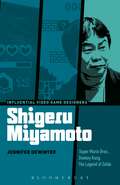- Table View
- List View
Ungovernable Life: Mandatory Medicine and Statecraft in Iraq
by Omar DewachiIraq's healthcare has been on the edge of collapse since the 1990s. Once the leading hub of scientific and medical training in the Middle East, Iraq's political and medical infrastructure has been undermined by decades of U.S.-led sanctions and invasions. Since the British Mandate, Iraqi governments had invested in cultivating Iraq's medical doctors as agents of statecraft and fostered connections to scientists abroad. In recent years, this has been reversed as thousands of Iraqi doctors have left the country in search of security and careers abroad. Ungovernable Life presents the untold story of the rise and fall of Iraqi "mandatory medicine"—and of the destruction of Iraq itself. Trained as a doctor in Baghdad, Omar Dewachi writes a medical history of Iraq, offering readers a compelling exploration of state-making and dissolution in the Middle East. His work illustrates how imperial modes of governance, from the British Mandate to the U.S. interventions, have been contested, maintained, and unraveled through medicine and healthcare. In tracing the role of doctors as agents of state-making, he challenges common accounts of Iraq's alleged political unruliness and ungovernability, bringing forth a deeper understanding of how medicine and power shape life and how decades of war and sanctions dismember projects of state-making.
Leisured Resistance: Villas, Literature and Politics in the Roman World (Classical Essays)
by Michael DewarLeisured Resistance examines the varied ways in which cultured Roman aristocrats, of very different periods, used their country estates as a political and literary tool. While for some the villas were retreats in which to compose literature and to escape from politics, others adapted this same tradition of cultured otium (or deliberate retirement from everyday politics) to present radical and competing visions of society and literature alike. Examining in-depth sources from both prose and verse from the time of Cicero to the last centuries of the Roman Empire in the west, the title demonstrates how the traditional image of the Roman aristocrat on his country estate was politically and socially very flexible: allowing authors, as times and circumstances changed, to present themselves or their patrons and friends as being in retreat from politics, or alternatively, as providing a focus for political opposition through the deliberate embracing of cultural values and schools of philosophy that offered resistance to prevailing political orthodoxy. The title ends by exploring how this tradition was adapted in the greatly changed world of the barbarian-ruled kingdoms that replaced direct Roman rule in Gaul in the fifth and sixth centuries.
Leisured Resistance: Villas, Literature and Politics in the Roman World (Classical Essays)
by Michael DewarLeisured Resistance examines the varied ways in which cultured Roman aristocrats, of very different periods, used their country estates as a political and literary tool. While for some the villas were retreats in which to compose literature and to escape from politics, others adapted this same tradition of cultured otium (or deliberate retirement from everyday politics) to present radical and competing visions of society and literature alike. Examining in-depth sources from both prose and verse from the time of Cicero to the last centuries of the Roman Empire in the west, the title demonstrates how the traditional image of the Roman aristocrat on his country estate was politically and socially very flexible: allowing authors, as times and circumstances changed, to present themselves or their patrons and friends as being in retreat from politics, or alternatively, as providing a focus for political opposition through the deliberate embracing of cultural values and schools of philosophy that offered resistance to prevailing political orthodoxy. The title ends by exploring how this tradition was adapted in the greatly changed world of the barbarian-ruled kingdoms that replaced direct Roman rule in Gaul in the fifth and sixth centuries.
The Networked Image in Post-Digital Culture
by Andrew DewdneyThis collection examines how the networked image establishes new social practices for the user and presents new challenges for cultural practitioners engaged in making, curating, teaching, exhibiting, archiving and preserving born-digital objects. The mode of vision and imaging, established through photography over the previous two centuries, has and continues to be radically reconfigured by a hybrid of algorithms, computing, programmed capture and display devices, and an array of online platforms. The image under these new conditions is filtered, fluid, fleeting, permeable, mobile and distributed and is changing our ways of seeing. The chapters in this volume are the outcome of research conducted at the Centre for the Study of the Networked Image (CSNI) and its collaboration with The Photographers’ Gallery over the last ten years. The book's contributors investigate radical changes in the meanings and values of hybridised media in socio-technical networks and speak to the creeping automation of culture through applications of AI, social media platforms and the financialisation of data. This interdisciplinary collection draws upon media and cultural studies, art history, art practice, photographic theory, user design, animation, museology and computer science as a way of making sense of the specific cultural consequences of the rapid succession of changes in image technologies and to bring the story up to date. It will be of particular interest to scholars and students of visual culture, media studies and photography.
Post Critical Museology: Theory and Practice in the Art Museum
by Andrew Dewdney David Dibosa Victoria WalshPost-Critical Museology considers what the role of the public and the experience of audiences means to the everyday work of the art museum. It does this from the perspectives of the art museum itself as well as from the visitors it seeks. Through the analysis of material gathered from a major collaborative research project carried out at Tate Britain in London the book develops a conceptual reconfiguration of the relationship between art, culture and society in which questions about the art museum’s relationship to global migration and the new media ecologies are examined. It suggests that whilst European museums have previously been studied as institutions of collection, heritage and tradition, however ‘modern’ their focus, it is now better to consider them as distributive networks in which value travels along transmedial and transcultural lines. Post-Critical Museology is intended as a contribution to progressive museological thinking and practice and calls for a new alignment of academics and professionals in what it announces as post-critical museology. An alignment that is committed to rethinking what an art museum in the twenty-first century could be, as well as what knowledge and understanding its future practitioners might draw upon in a rapidly changing social and cultural context. The book aims to be essential reading in the growing field of museum studies. It will also be of professional interest to all those working in the cultural sphere, including museum professionals, policy makers and art managers.
Post Critical Museology: Theory and Practice in the Art Museum
by Andrew Dewdney David Dibosa Victoria WalshPost-Critical Museology considers what the role of the public and the experience of audiences means to the everyday work of the art museum. It does this from the perspectives of the art museum itself as well as from the visitors it seeks. Through the analysis of material gathered from a major collaborative research project carried out at Tate Britain in London the book develops a conceptual reconfiguration of the relationship between art, culture and society in which questions about the art museum’s relationship to global migration and the new media ecologies are examined. It suggests that whilst European museums have previously been studied as institutions of collection, heritage and tradition, however ‘modern’ their focus, it is now better to consider them as distributive networks in which value travels along transmedial and transcultural lines. Post-Critical Museology is intended as a contribution to progressive museological thinking and practice and calls for a new alignment of academics and professionals in what it announces as post-critical museology. An alignment that is committed to rethinking what an art museum in the twenty-first century could be, as well as what knowledge and understanding its future practitioners might draw upon in a rapidly changing social and cultural context. The book aims to be essential reading in the growing field of museum studies. It will also be of professional interest to all those working in the cultural sphere, including museum professionals, policy makers and art managers.
The Digital Media Handbook
by Andrew Dewdney Peter RideThe new edition of The Digital Media Handbook presents an essential guide to the historical and theoretical development of digital media, emphasising cultural continuity alongside technological change, and highlighting the emergence of new forms of communication in contemporary networked culture. Andrew Dewdney and Peter Ride present detailed critical commentary and descriptive historical accounts, as well as a series of interviews from a range of digital media practitioners, including producers, developers, curators and artists. The Digital Media Handbook highlights key concerns of today’s practitioners, analysing how they develop projects, interact and solve problems within the context of networked communication. The Digital Media Handbook includes: Essays on the history and theory of digital media Essays on contemporary issues and debates Interviews with digital media professionals A glossary of technical acronyms and key terms.
The Digital Media Handbook
by Andrew Dewdney Peter RideThe new edition of The Digital Media Handbook presents an essential guide to the historical and theoretical development of digital media, emphasising cultural continuity alongside technological change, and highlighting the emergence of new forms of communication in contemporary networked culture. Andrew Dewdney and Peter Ride present detailed critical commentary and descriptive historical accounts, as well as a series of interviews from a range of digital media practitioners, including producers, developers, curators and artists. The Digital Media Handbook highlights key concerns of today’s practitioners, analysing how they develop projects, interact and solve problems within the context of networked communication. The Digital Media Handbook includes: Essays on the history and theory of digital media Essays on contemporary issues and debates Interviews with digital media professionals A glossary of technical acronyms and key terms.
The Networked Image in Post-Digital Culture
by Andrew Dewdney Katrina SluisThis collection examines how the networked image establishes new social practices for the user and presents new challenges for cultural practitioners engaged in making, curating, teaching, exhibiting, archiving and preserving born-digital objects. The mode of vision and imaging, established through photography over the previous two centuries, has and continues to be radically reconfigured by a hybrid of algorithms, computing, programmed capture and display devices, and an array of online platforms. The image under these new conditions is filtered, fluid, fleeting, permeable, mobile and distributed and is changing our ways of seeing. The chapters in this volume are the outcome of research conducted at the Centre for the Study of the Networked Image (CSNI) and its collaboration with The Photographers’ Gallery over the last ten years. The book's contributors investigate radical changes in the meanings and values of hybridised media in socio-technical networks and speak to the creeping automation of culture through applications of AI, social media platforms and the financialisation of data. This interdisciplinary collection draws upon media and cultural studies, art history, art practice, photographic theory, user design, animation, museology and computer science as a way of making sense of the specific cultural consequences of the rapid succession of changes in image technologies and to bring the story up to date. It will be of particular interest to scholars and students of visual culture, media studies and photography.
Lernen zwischen Vergewisserung und Ungewißheit: Reflexives Handeln in der Erwachsenenbildung (Studien zur Erziehungswissenschaft und Bildungsforschung #14)
by Bernd DeweDie in diesem Buch entfalteten Positionen moderner Erwachsenenbildung kennzeichnen lebenslanges Lernen unter dem Gesichtspunkt der Selbstentfaltung und Selbstreflexion der lernenden Akteure. Dabei hat die Einsicht in die sich biografisch stets neu ergebende Notwendigkeit der Vergewisserung über die eigenen Handlungsmöglichkeiten eine ebenso große Bedeutung wie die Erkenntnis, daß reflexives Lernen im Lebenslauf immer wieder die Vergegenwärtigung von neuen Ungewißheiten im Handeln, Entscheiden und Begründen bedingt. Aus der Sicht der Teilnehmer und der professionell Handelnden wird institutionalisierte Erwachsenenbildung in den ersten acht Kapiteln im Verhältnis von Handlung, Rationalität und Wissen analysiert. Von den sieben Kapiteln unter dem Schwerpunkt Handlung, Bildung und Lernerfahrung beschäftigen sich die ersten fünf mit verschiedenen Aspekten des Verhältnisses von Bildungsangeboten und den Aneignungsperspektiven von Erwachsenen. Die letzten beiden Beiträge zeigen Neuland bzw. Grenzbereiche der Erwachsenenbildung auf.
Erziehen als Profession: Zur Logik professionellen Handelns in pädagogischen Feldern
by Bernd Dewe Wilfried Ferchhoff Frank-Olaf RadtkeAuf dem Wege zu einer aufgabenzentrierten Professionstheorie pädagogischen Handeins I. Die Verberuflichung des Erziehens ist historisch weitgehend abgeschlossen. In den modemen Industrie-und Dienstleistungsgesellschaften hat sich ein eigenständiger Sektor der institutionalisierten Erziehung ausdifferenziert, der mittlerweile zu einem der größten Teilsysteme der Gesellschaft geworden ist und immer größere Gruppen der Bevölkerung durch alle Lebensphasen hindurch erfaßt. In diesem Sektor ist eine Vielzahl von Berufen entstanden, zu der die Kindergärtnerin, die Lehrerin, die Sozialpädagogin, die Erziehungsberaterin, die Erwachsenenbildnerin und bald auch die Gerontagogin rechnet. Sie decken ein weites Spektrum von erzieherischen Tätigkeiten ab und sind - gemessen an der Ausbildungsart und -dauer -auf ganz unterschiedlichen Qualifikationsniveaus angesiedelt: von der Erzieherin mit Fach schulausbildung über Fachhochschulabsolventinnen z. B. der Sozialpädagogik, über Lehrer verschiedener Schulstufen mit akademischer oder universitärer Ausbildung bis zu Diplom-Pädagoginnen mit und ohne Promotion. Sie alle erziehen - sei es der Absicht nach, sei es beiläufig oder verschämt. Unerledigt ist die Frage der Professionalisierung des Erziehens. Die Formulie rung und die Institutionalisierung pädagogischer Berufsbilder und ihre Legitimation durch entsprechende Zertifikate stellen keine Garantie für Professionalität dar. Dies gilt jedenfalls dann, wenn unter Professionalisierung nicht nur der historische Prozeß gemeint ist, in dem sich eine Gruppe von Berufen etablieren konnte, sondern auch die Ausbildung einer spezifischen Handlungskompetenz, die von der Struktur der professionellen Handlung erfordert wird.
Animal Spirits with Chinese Characteristics: Investment Booms and Busts in the World’s Emerging Economic Giant
by M. DeWeaverWill China eventually be able to eliminate its socialist animal spirits? Highlighting the importance of China's investment booms and busts for both the Chinese and the world economy, Animal Spirits with Chinese Characteristics describes the origins and evolution of the investment cycle during the command economy period.
The Audience in the News (Routledge Communication Series)
by Dwight DeWerth-PallmeyerIn recent years, communication scholars have taken a renewed interest in analyzing the audience and its impact on the communication process. Similarly, news editors and producers have often turned toward a marketing orientation which seeks to give new readers and viewers what they want, or at least what they say they want. Yet, there has still been little written about just how the audience factors into the news which is produced. Seeking to fill that niche, this book argues that audience images are quite important in the construction of news, but not easily detected. That is because journalists are not principally interested in their audience; they are interested in the news. USE THIS PARAGRAPH ONLY FOR GENERAL CATALOGS... This volume argues that although journalistic images of the audience may be "incomplete," they do exist and powerfully help shape the work of journalists in producing journalistic texts. Using a case study of news workers and news texts at two Chicago newsgathering organizations, the Chicago Tribune and WGN-TV, this book: * examines notions of audience and how they have been treated by academicians, * presents a detailed description of the ways in which audience is embedded within the news construction process, * presents a very representative set of journalistic news values, * presents differing ideas of audience at three key levels of the news organizations -- reporters and news gatherers, editors and producers, and senior editors, producers, and news directors, and * seeks to summarize and position this study within the larger body of mass communication research.
The Audience in the News (Routledge Communication Series)
by Dwight DeWerth-PallmeyerIn recent years, communication scholars have taken a renewed interest in analyzing the audience and its impact on the communication process. Similarly, news editors and producers have often turned toward a marketing orientation which seeks to give new readers and viewers what they want, or at least what they say they want. Yet, there has still been little written about just how the audience factors into the news which is produced. Seeking to fill that niche, this book argues that audience images are quite important in the construction of news, but not easily detected. That is because journalists are not principally interested in their audience; they are interested in the news. USE THIS PARAGRAPH ONLY FOR GENERAL CATALOGS... This volume argues that although journalistic images of the audience may be "incomplete," they do exist and powerfully help shape the work of journalists in producing journalistic texts. Using a case study of news workers and news texts at two Chicago newsgathering organizations, the Chicago Tribune and WGN-TV, this book: * examines notions of audience and how they have been treated by academicians, * presents a detailed description of the ways in which audience is embedded within the news construction process, * presents a very representative set of journalistic news values, * presents differing ideas of audience at three key levels of the news organizations -- reporters and news gatherers, editors and producers, and senior editors, producers, and news directors, and * seeks to summarize and position this study within the larger body of mass communication research.
The School and Society & The Child and the Curriculum (Centennial Publications Of The University Of Chicago Press Ser.)
by John DeweyOne of the most influential forces in the shaping of American education, the famed philosopher and psychologist John Dewey (1859–1952) believed in "viewing the education of the child in the light of the principles of mental activity and processes of growth made know by modern psychology." As the administrator of the University of Chicago's laboratory school — which he established in 1896 and which was one of the first such schools in the United States — Dewey came to the realization that learning was a process starting from uncertainty and growing from the impulse which must begin with experience, and the curriculum must be made to relate to the students' interests.The two books in this volume — both short, but extremely influential — grew out of Dewey's hands-on experience with the laboratory school and represent the earliest authoritative statement of his revolutionary emphasis on education as an experimental, child-centered process, In The School and Society, he declares that we must "make each one of our schools an embryonic community life, active with types of occupations that reflect the life of the larger society and permeated with the spirit of art, history, and science." In The Child and the Curriculum, he stresses the importance of the curriculum as a means of determining the environment of the child, and allowing the teacher to guide children in asserting themselves, exercising their capacities, and fulfilling the destinies of their own nature.Gathered in this single convenient volume, these thought-provoking contributions by one of America's greatest thinkers in the field of pedagogy will be immense interest to educators, psychologists, parents, and anyone interested in the psychology and philosophy of childhood education.
Neon Wasteland: On Love, Motherhood, And Sex Work In A Rust Belt Town
by Susan DeweyThis path-breaking book examines the lives of five topless dancers in the economically devastated "rust belt" of upstate New York. With insight and empathy, Susan Dewey shows how these women negotiate their lives as parents, employees, and family members while working in a profession widely regarded as incompatible with motherhood and fidelity. Neither disparaging nor romanticizing her subjects, Dewey investigates the complicated dynamic of performance, resilience, economic need, and emotional vulnerability that comprises the life of a stripper. An accessibly written text that uses academic theories and methods to make sense of feminized labor, Neon Wasteland shows that sex work is part of the learned process by which some women come to believe that their self-esteem, material worth, and possibilities for life improvement are invested in their bodies.
Routledge International Handbook of Sex Industry Research (Routledge International Handbooks)
by Susan Dewey Isabel Crowhurst Chimaraoke IzugbaraThe Routledge International Handbook of Sex Industry Research unites 45 contributions from researchers, sex workers, activists, and practitioners who live and work in 28 countries throughout the world. Focusing tightly on the contemporary state of sex industry research through eight carefully selected themes, this volume sets a clear agenda for future research, activism, and policymaking. Approaching the topic from a multidisciplinary perspective on an expanding field frequently divided by political and ideological conflicts, the handbook clearly establishes the parameters of the field while also showcasing the most vibrant contemporary empirical and theoretical work. Unprecedented in its global scope, the Routledge International Handbook of Sex Industry Research will appeal to students, researchers, and policy makers interested in fields such as sociology of gender and sexuality; crime, justice, and the sex industry; sociology of work and professions; and sexual politics.
Ethical Research with Sex Workers: Anthropological Approaches (SpringerBriefs in Anthropology)
by Susan Dewey Tiantian ZhengThis volume is the result of the many years the authors have spent conducting ethnographic field research with sex workers, conversing with other researchers, and, perhaps most importantly, developing a deep sense of empathy for the sex worker participants in the research as well as the colleagues who carry out this work with the goal of advancing social justice. They have a combined total of twenty-five years’ experience carrying out research with sex workers, and this extensive period of time has given them ample opportunity to reflect upon the topic of ethics. Sex work, defined as the exchange of sexual or sexualized intimacy for money or something of value, encompasses a wide range of legal and illegal behaviors that present researchers with key ethical challenges explored in the volume. These ethical challenges include:· Research methodology· Distinguishing research from activism· Navigating the politically and ideologically charged environments in which researchers must remain constantly attuned to the legal and public policy implications of their work· Possibilities for participatory sex work research processes· Strategies for incorporating participants in a variety of collaborative waysSex work presents a unique set of challenges that are not always well understood by those working outside of anthropology and disciplines closely related to it. This book serves an important function by honestly and openly reviewing strategies for overcoming these ethical challenges with the end goal of producing path-breaking research that actively incorporates the perspectives of research participants on their own terms. Ever attuned to the reality that research on sex work remains a deeply political act, Ethical Research with Sex Workers: Anthropological Approaches aspires to begin a dialogue about the meanings and practices ascribed to ethics in a fraught environment. Drawing upon a review of published scholarly and activist work on the subject, as well as on interviews with researchers, social service providers, and sex workers themselves, this volume is an unprecedented contribution to the literature that will engage researchers across a variety of disciplines, such as academics and researchers in anthropology, sociology, criminal justice, and public health, as well as activists and policymakers.
Sex Workers and Criminalization in North America and China: Ethical and Legal Issues in Exclusionary Regimes (SpringerBriefs in Anthropology #0)
by Susan Dewey Tiantian Zheng Treena OrchardSex work continues to provoke controversial legal and public policy debates world-wide that raise fundamental questions about the state’s role in protecting individual rights, status quo social relations, and public health. This book unites ethnographic research from China, Canada, and the United States to argue that criminalization results in a totalizing set of negative consequences for sex workers’ health, safety, and human rights. Such consequences are enabled through the operations of an exclusionary regime, a dense coalescence of punitive forces that involves both governance, in the form of the criminal justice system and other state agents, and dynamic interpersonal encounters in which individuals both enforce and negotiate stigma-related discrimination against sex workers. Chapter Two demonstrates how criminalization harms sex workers by isolating their work to potentially dangerous locations, fostering mistrust of authority figures, further limiting their abilities to find legal work and housing, and restricting possibilities for collective rights-based organizing. Criminalized sex workers report police harassment, seizure of condoms, and adversarial police-sex worker relations that enable others to abuse them with impunity. Chapter Three describes how sex workers negotiate these restrictions on their rights and personal autonomy via their arrest avoidance and client management strategies, self-treatment of health issues, selective mutual aid, rights-based organizing, and entrenchment in sex work or other criminalized activities. Chapter Four describes how researchers working in countries or locales that criminalize sex work face ethical concerns as well as barriers to their work at the practical, institutional, and political levels.
The Transnational Voices of Australia’s Migrant and Minority Press (Palgrave Studies in the History of the Media)
by Catherine Dewhirst Richard ScullyThis edited collection invites the reader to enter the diverse worlds of Australia’s migrant and minority communities through the latest research on the contemporary printed press, spanning the mid-nineteenth century to our current day. With a focus on the rare, radical and foreign-language print culture of multiple and frequently concurrent minority groups’ newspaper ventures, this volume has two overarching aims: firstly to demonstrate how the local experiences and narratives of such communities are always forged and negotiated within a context of globalising forces – the global within the local; and secondly to enrich an understanding of the complexity of Australian ‘voices’ through this medium not only as a means for appreciating how the cultural heritage of such communities were sustained, but also for exploring their contributions to the wider society.
Voices of Challenge in Australia’s Migrant and Minority Press (Palgrave Studies in the History of the Media)
by Catherine Dewhirst Richard ScullyThis book brings together long-obscured histories to discuss Australia’s cultural, social, and political diversity in depth. The history of Australia’s migrant and minority print media reveals extensive evidence for the nation’s global connectedness, from the colonial era to today. A fascinating and complex picture of Australia’s long-term transnational ties emerges from the smaller enterprises of individuals and communities in the distant and more recent past. This book explores the authentic voices of minority groups which challenged the dominant experiences, patterns, and debates that have shaped Australia.
Underdogs: The Unlikely Story of Football’s First FA Cup Heroes
by Keith Dewhurst'Fancy! A lot of working chaps beating a lot of gentlemen!'1879, the third round of the FA Cup. A football team from the humble Lancashire cotton town of Darwen take on Remnants - a Berkshire club of the moneyed and well-connected - and beat them. It is football's first ever giantkilling. Their reward is a quarter-final with the mighty Old Etonians. It pitches rulers against ruled, rich against poor, champions against underdogs, old tactics against new, the inventors of the game against the upstarts. It is an encounter that is seen as symbolic. And, hidden at the heart of the encounter, lies the bitterest controversy.Underdogs is a fascinating story that covers the very birth of football and its development towards the game we recognise today. Storyteller, football connoisseur and historian, Keith Dewhurst, shows how 130 years ago, at its beginning, football was already reflecting the modern game closely - money talks, cheating abounds, and victory is secured whatever the cost.'Fascinating... The beginning of professionalism, a change in the style of playing, the end of southern amateur Oxbridge chaps dominating football... Keith has done an excellent research job in recreating the times and tensions' Spectator
Gender and Politics in Post-Reformasi Indonesia: Women Leaders within Local Oligarchy Networks
by Kurniawati Hastuti DewiThis book employs a gendered perspective to uncover an in-depth understanding of the political role of women leaders in local government in Indonesia. Beginning with the story of two women who successfully won the local elections in Indramayu in 2010 and Tangerang Selatan in 2011, respectively, the book uses their experiences as a point of departure to present a discussion on female political leaders’ part within the larger political dynastic structure in Indonesia. The book explores the multiple challenges and difficulties that these women encountered in reaching power and in promoting local democracy, highlighting the patriarchal nature of the oligarchy. In doing so, this book provides a rich empirical account of the current features of female political leaders and their political and familial, linkages. The research, thus, contributes significantly to the work of scholars and political activists seeking to unpack the process and progress of democratization in post-reformasi Indonesia, in which women’s political participation and leadership are an inevitable and vital part. In doing so, the book champions how Indonesian women are playing an increasingly important role in the democratic process, even in the face of the enduring challenges posed by familial ties and political dynasty factors that continue to hinder democratization—trends that are also prevalent across multiple Southeast Asian countries in the twenty-first century. Relevant to scholars and students situated at the intersection of gender and politics, this translated and updated co-publication is a tour de force, led by one of Indonesia’s seminal scholars in women’s studies.
Shigeru Miyamoto: Super Mario Bros., Donkey Kong, The Legend of Zelda (Influential Video Game Designers)
by Jennifer DeWinterVideo games are considered by many to be just entertainment-essentially void of skillful, artistic intervention. But as any gamer knows, there's incredible technical and graphic talent behind even a flickering Gameboy screen.You may have never heard Shigeru Miyamoto's name, but you've probably spent many a lazy afternoon absorbed in his work. Joining Nintendo as a video game designer in the late 1970s, Miyamoto created the powerhouse franchises Super Mario Bros., The Legend of Zelda, and Donkey Kong-games so ubiquitous that Miyamoto was named one of TIME's 100 Most Influential People in 2007. Combining critical essays with interviews, bibliographies, and striking visuals, Shigeru Miyamoto unveils the artist behind thousands of glowing gaming screens, tracing out his design decisions, aesthetic preferences, and the material conditions that shaped his work. With this incredible (and incredibly unknown) figure, series editors Jennifer DeWinter and Carly Kocurek launch the Influential Video Game Designers series, at last giving these artists the recognition they deserve.
Shigeru Miyamoto: Super Mario Bros., Donkey Kong, The Legend of Zelda (Influential Video Game Designers)
by Jennifer DeWinterVideo games are considered by many to be just entertainment-essentially void of skillful, artistic intervention. But as any gamer knows, there's incredible technical and graphic talent behind even a flickering Gameboy screen.You may have never heard Shigeru Miyamoto's name, but you've probably spent many a lazy afternoon absorbed in his work. Joining Nintendo as a video game designer in the late 1970s, Miyamoto created the powerhouse franchises Super Mario Bros., The Legend of Zelda, and Donkey Kong-games so ubiquitous that Miyamoto was named one of TIME's 100 Most Influential People in 2007. Combining critical essays with interviews, bibliographies, and striking visuals, Shigeru Miyamoto unveils the artist behind thousands of glowing gaming screens, tracing out his design decisions, aesthetic preferences, and the material conditions that shaped his work. With this incredible (and incredibly unknown) figure, series editors Jennifer DeWinter and Carly Kocurek launch the Influential Video Game Designers series, at last giving these artists the recognition they deserve.

